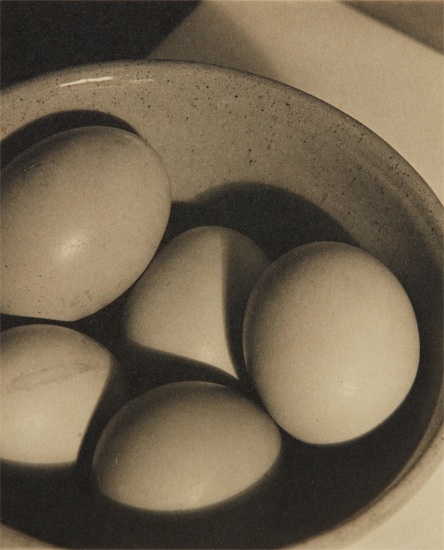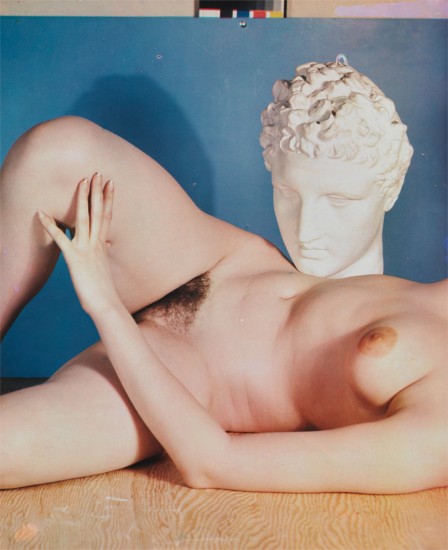Paul Outerbridge Jr. Standing Nude with Chair circa 1924 Platinum print. 6 5/8 x 4 in. (16.8 x 10.2 cm) Laguna Beach Art Association Collection label affixed to the reverse of the mount.
Provenance The Estate of Paul Outerbridge Jr. Gifted from Lois Cunningham Outerbridge to the Laguna Beach Art Museum, 1968 Sold to benefit the Museum's Acquisitions Fund, Christie's New York, 23 April 1996, lot 289 Christie's, New York, 20 October 2003, lot 126 Exhibited Paul Outerbridge A Singular Aesthetic, Photographs and Drawings, 1921-1941: Laguna Art Museum, 21 November 1981 – 10 January 1982 and 15 other venues, including the San Francisco Museum of Modern Art, 22 January – 7 March 1982; the International Center of Photography, New York, 9 July – 8 August 1982; Kunsthalle, Cologne, 17 September – 12 October 1982; and the Minneapolis Institute of the Arts, 12 November 1982 – 2 January 1983 Literature Dines, A Singular Aesthetic, pl. 42 Schirmer Art Books, Paul Outerbridge Jr.: Photographs, pl. 15 Taschen, Paul Outerbridge p. 120 Catalogue Essay In 1915, at the age of nineteen, Paul Outerbridge Jr., decided to forgo the Harvard-bound trajectory outlined by his parents in favor of enrolling at the Art Students League in New York, where he studied anatomy and aesthetics. The combination of the two subjects was apt, for the budding artist was to seamlessly synthesize his fascination with the female form with his strong artistic sensibilities over the following decades. Moreover, it was around that time that Outerbridge began earning income designing posters for the theater, another subject that would come to deeply inform his studies of the female form. Outerbridge’s dedication to the arts persisted, and in 1921 he enrolled at the Clarence H. White School of Photography at Columbia University. It was there that he challenged and subsequently enriched his knowledge of art and photography under the tutelage of the Russian Constructivist Alexander Archipenko and the avant-garde painter Max Weber Thelatter, in particular, was of great influence, teaching young Outerbridge the writings of Arthur Wesley Dow on Cubist compositions in art and photography. This neatly complemented Outerbridge’s readings on Paul Strand in Camera Work, especially his championing of the integral tenets of Formalism: clarity, linearity and tonality. In the current lot, Outerbridge created a visual symphony of lines that despite its initial simplicity, was carefully orchestrated. The model’s back is turned to the viewers as she leans forward, her right arm parallels her left leg, while her right leg is bent to parallel her torso. A play of shadow and light permeates the image, especially over the Windsor-back chair and the vertical molding on the wall. Subsequently, the lines and curves and angles comprising the model are in harmony with those found in her surrounding. Such Formalist sensitivities belying the image resonate with the nude studies produced by other Modernist photographers throughout the 1920s on both sides of the Atlantic, from Edward Weston’s abstracted nudes to Frantisek Drtikol’s Deco beauties and Alfred Stieglitz’s linear compositions of his beloved Georgia O’Keeffe. Outerbridge’s image, Standing Nude with Chair, undoubtedly belongs among the strongest examples of figural Formalism of the period. Nonetheless, despite the formalist undertones, there is a personal component that is uniquely Outerbridge’s. Referencing his love for theater, German Expressionist cinema, and the notion of Ideal Beauty in the current lot, Outerbridge reminds viewers that the formalist nude study in the photograph is unequivocally his own. Indeed, by turning the model away from the viewers and hiding her face Outerbridge created an image that feeds on the lure of anonymous role-play and the enigma of theatrical sensuality. Additionally, by opting for a platinum paper—a highly scarce commodity in the 1920s—Outerbridge highlighted the importance, rarity and desirability of the image. Collectively, therefore, this image is as much an homage to Formalism as it is a voyeuristic glimpse of the photographer’s creative vision. “The nude is by far the most difficul
Paul Outerbridge Jr. Standing Nude with Chair circa 1924 Platinum print. 6 5/8 x 4 in. (16.8 x 10.2 cm) Laguna Beach Art Association Collection label affixed to the reverse of the mount.
Provenance The Estate of Paul Outerbridge Jr. Gifted from Lois Cunningham Outerbridge to the Laguna Beach Art Museum, 1968 Sold to benefit the Museum's Acquisitions Fund, Christie's New York, 23 April 1996, lot 289 Christie's, New York, 20 October 2003, lot 126 Exhibited Paul Outerbridge A Singular Aesthetic, Photographs and Drawings, 1921-1941: Laguna Art Museum, 21 November 1981 – 10 January 1982 and 15 other venues, including the San Francisco Museum of Modern Art, 22 January – 7 March 1982; the International Center of Photography, New York, 9 July – 8 August 1982; Kunsthalle, Cologne, 17 September – 12 October 1982; and the Minneapolis Institute of the Arts, 12 November 1982 – 2 January 1983 Literature Dines, A Singular Aesthetic, pl. 42 Schirmer Art Books, Paul Outerbridge Jr.: Photographs, pl. 15 Taschen, Paul Outerbridge p. 120 Catalogue Essay In 1915, at the age of nineteen, Paul Outerbridge Jr., decided to forgo the Harvard-bound trajectory outlined by his parents in favor of enrolling at the Art Students League in New York, where he studied anatomy and aesthetics. The combination of the two subjects was apt, for the budding artist was to seamlessly synthesize his fascination with the female form with his strong artistic sensibilities over the following decades. Moreover, it was around that time that Outerbridge began earning income designing posters for the theater, another subject that would come to deeply inform his studies of the female form. Outerbridge’s dedication to the arts persisted, and in 1921 he enrolled at the Clarence H. White School of Photography at Columbia University. It was there that he challenged and subsequently enriched his knowledge of art and photography under the tutelage of the Russian Constructivist Alexander Archipenko and the avant-garde painter Max Weber Thelatter, in particular, was of great influence, teaching young Outerbridge the writings of Arthur Wesley Dow on Cubist compositions in art and photography. This neatly complemented Outerbridge’s readings on Paul Strand in Camera Work, especially his championing of the integral tenets of Formalism: clarity, linearity and tonality. In the current lot, Outerbridge created a visual symphony of lines that despite its initial simplicity, was carefully orchestrated. The model’s back is turned to the viewers as she leans forward, her right arm parallels her left leg, while her right leg is bent to parallel her torso. A play of shadow and light permeates the image, especially over the Windsor-back chair and the vertical molding on the wall. Subsequently, the lines and curves and angles comprising the model are in harmony with those found in her surrounding. Such Formalist sensitivities belying the image resonate with the nude studies produced by other Modernist photographers throughout the 1920s on both sides of the Atlantic, from Edward Weston’s abstracted nudes to Frantisek Drtikol’s Deco beauties and Alfred Stieglitz’s linear compositions of his beloved Georgia O’Keeffe. Outerbridge’s image, Standing Nude with Chair, undoubtedly belongs among the strongest examples of figural Formalism of the period. Nonetheless, despite the formalist undertones, there is a personal component that is uniquely Outerbridge’s. Referencing his love for theater, German Expressionist cinema, and the notion of Ideal Beauty in the current lot, Outerbridge reminds viewers that the formalist nude study in the photograph is unequivocally his own. Indeed, by turning the model away from the viewers and hiding her face Outerbridge created an image that feeds on the lure of anonymous role-play and the enigma of theatrical sensuality. Additionally, by opting for a platinum paper—a highly scarce commodity in the 1920s—Outerbridge highlighted the importance, rarity and desirability of the image. Collectively, therefore, this image is as much an homage to Formalism as it is a voyeuristic glimpse of the photographer’s creative vision. “The nude is by far the most difficul



.jpg)
.jpg)
.jpg)



Try LotSearch and its premium features for 7 days - without any costs!
Be notified automatically about new items in upcoming auctions.
Create an alert